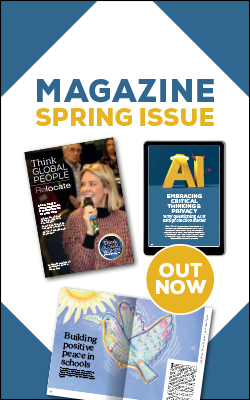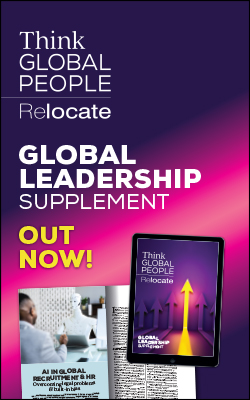Future-proofing your organisation: the importance of measuring and defining culture
In an era of rapid adoption of technology, and in the aftermath of one of the greatest changes to working practices in several generations, researchers are looking at how measuring a company’s culture can enhance employee satisfaction and business success and help guard against catastrophic mistakes. Marianne Curphey reports from the CIPD annual conference.

This article is taken from the Leadership Supplement from
Relocate Think Global People
Click on the cover to access the digital edition.“Culture is not just one aspect of the game. It is the game. In the end, an organisation is nothing more than the collective capacity of its people to create value.” Lou Gerstner, former IBM CEO
No two workplaces are exactly alike and each has its own culture. Some workplace cultures complement business goals and drive strategy forward. Others may have important elements lacking or even unintentionally reward harmful behaviours, which could hold back progress or compromise the organisation.Cultural analytics has emerged as a vital area for organisations to explore if they want to understand what role culture plays and how it affects employee behaviour and business outcomes. There is, however, a significant challenge in defining and measuring culture and reviews of culture in organisations are often backwards-looking. However, workplaces that understand their culture and take active steps to enhance it can leverage it as a strategic asset for their future success.Speaking at the CIPD conference in Manchester in November, Hani Nabeel, chief behavioural and data scientist at iPsychTec, a world-leading people analytics and behavioural science company, explained how cultural analytics referred to the application of data-driven approaches to measure, understand and enhance an organisation's culture in a way that directly aligns with its goals.He explained it is about actively connecting management styles, incentives and rewards with successful business outcomes. “We want culture to drive performance, to allow people to do great things every day at work, and also we want culture to stop us doing horrid things,” he said. “So it's that continuous challenge between risk and reward that we want out of culture.”As part of the conference presentation on ‘Building a future-ready workforce: a skills-based approach to strategic workforce planning’, Hani explained how the insights drawn from an analysis of workplace culture offer organisations a guide to improving learning, engagement and performance. However, because each organisation is unique, there is no universal approach, he explained. It isn’t possible to just copy another company’s blueprint for culture change and hope that it will work for you.“The uniqueness of what you have got – the uniqueness of the environment, your rules, your processes, your environment – are critical,” he says. “They are unique to your culture. It is not just robotic and you cannot borrow culture from somewhere or another company and try to cut, copy and paste. That will not get the outcome that you are hoping for.”
Why your organisation’s culture matters
Leaders may find the concept of culture difficult to quantify and even harder to change. Yet the need for cultural analytics and positive action stems from an increased awareness that an organisation's culture significantly impacts its long-term success.Cultures that promote growth, accountability and psychological safety support an organisation’s ability to adapt, perform and retain talent. On the other side, toxic behaviours or a culture of poor governance can lead to disengagement, inefficiency and even crises.Hani Nabeel cites examples of well-known companies where there was a failure of culture, including Boeing’s safety concerns, the emissions scandal at VW and the collapse of Enron. All three were major international well-respected companies where gaps in culture led to mistakes and ultimately ended in brand damage and adverse financial repercussions. He argues that when most companies do look at culture, they are looking backwards, which is of minimal value and cannot help in moving the company forward.Boeing: In 2018 and 2019, two of Boeing’s 737 Max planes crashed, killing 346 people. The crashes were later found to have been caused by faulty flight control software that Boeing had allegedly concealed from regulators.VW: By allegedly tampering with software used in safety tests, VW diesel cars were able to pass safety tests, even though when used on the road their engines were said to have emitted nitrogen oxide pollutants up to 40 times above what is allowed in the United States.Enron: Enron was an energy trading company that collapsed after a massive accounting fraud scheme was revealed. Its 2001 bankruptcy filing was the largest in American history at the time and estimated losses totalled $74 billion. Arthur Andersen, Enron's auditor, ceased doing business after the scandal. Shareholders lost $11 billion and the scandal damaged the US stock market's reputation for transparency and compliance.What common mistakes do leaders make when measuring culture?
Hani says leaders often leave organisational culture up to chance rather than taking active steps to think about what type of culture would enhance success and where dangerous gaps might lie.“They look at mostly lagging indicators,” he says. “Has the performance been great? Are people engaged? Are employees happy to be here? These are all lagging indicators. Once they happen, you can't change that because it is the narrative.”The value of cultural analytics lies in its ability to connect intangible cultural elements with measurable outcomes, he says. By doing so, it allows organisations to identify behaviours that lead to positive performance outcomes or, conversely, those that hinder growth or are fostering behaviours that could undermine their reputation or their financial security.“Often, we talk about culture in fuzzy terms, but it is rarely connected to hard outcomes,” he says. “So, we can make the case for anything – make the case for change, make the case for risk management, make the case for performance and so on – but it is not going to get us there and it hasn't got us there so far.”He says problems with measuring and defining culture in organisations happen because of:- Poor measurement metrics: Often leaders define cultural values based on personal hunches or copying generic industry trends, measuring culture inappropriately through engagement sentiment surveys or qualitative investigations with no clarity on the link between their unique organisational culture and critical business outcomes.
“Leaders get caught out by the wrong behaviours and values becoming dominant in their organisations, wasting enormous resources on measures or interventions that have no tangible impact or even a negative impact on desired behaviours and business outcomes,” he says.
- Defining culture in narrow terms based on the experiences of the senior management team: Mission statements are written by a few members of the leadership elite who go on an away day together and come up with a slogan that they display in reception, Hani says. “The truth is this is not written from the ground up. We don't know whether people actually behave according to these values or just treat them as fashionable words.”
- Not understanding the impact of behaviours that are embedded in the workplace: A misunderstanding of an organisation’s real culture, rather than the varnished one that senior leaders may imagine exists, might lead to shortcuts or even unethical behaviours. Also, rewarding certain behaviours without considering what unintended outcome they might have could result in a lack of accountability or reduced motivation. “Striking a balance by aligning workplace behaviours with desired outcomes enables organisations to navigate challenges and adapt to evolving circumstances,” he says.
- Trying to import existing cultures onto yours: Just as a neighbour’s key won't fit your front door, their organisational strategies won't necessarily unlock success in your company. “Emulating external models without adapting them to your unique culture is a misstep,” he says. “Beware of off-the-shelf consultants. While external guidance can provide valuable insights, it is crucial to ensure consultants are tailoring strategies to your organisation rather than deploying a generic playbook.”
- Not setting the standards for your organisation: Leaders are the custodians of organisational culture, but every employee is accountable for it. Leaders need to be behavioural champions, but you need to create a workplace environment that enables all employees to champion these positive behaviours. “This is why you should adopt workplace culture by design,” Hani says. “If you don't actively set the behavioural standards for your organisation, you tend to end up with negative behaviours, which can harm your workplace environment. With a clear plan, you can build a culture that matches your goals and ensure success.”
Read related articles
- How to tackle resistance to cultural change in the workplace
- Rethinking DEI? Women, equity and work
- How to create a diverse and inclusive workplace
- How to achieve true equality in the workplace
Key metrics in cultural analytics – what does it mean to measure culture?
Analytics help you create value through using behavioural science to understand your culture and your people, he says. “You get to know why events have happened in behavioural terms and you get an understanding of why organisational frameworks or values are being lived or not and where,” he says.You can then work out how to drive change and make improvements, what outcomes will be impacted by these changes and by how much, what your return on investment (ROI) will be and how to construct an optimal roadmap to drive behavioural change.The real differences cultural analytics can deliver are foresight and a deep understanding of how difficulties might appear in the future, he says. “You can apply that lens across the whole organisation to discover where future issues may arise, helping you drive behavioural change before undesirable outcomes or events happen. In other words, it helps you measure and deliver actionable behavioural insights effectively and efficiently.”Rewarding the wrong behaviour creates negative outcomes
In his case study of a start-up tech company, the road map to a thriving team included an effective work-life balance, accountability, psychological safety, recognition of performance and good quality coaching, all of which enhanced the effectiveness of the business.It is important to see where you might be rewarding behaviours that are harming the company. For example, in some organisations, you are 14 times more likely to be classed a high-performer if you are self-focused rather than prioritising team and group efforts, but these self-focused behaviours may actively work against some of the results you are looking to achieve.“When a company is able to define and measure its culture it gains real-time information into what is working and what is not across the whole of the organisation,” he says. By using these insights, leaders and managers can create robust business strategies, which can drive a culture of innovation, ensure protocols and safety procedures are followed and reinforce good governance.In turn, this should help protect an organisation against the kind of reputational damage that happened as a result of shortcuts at Boeing and VW and the financial mismanagement and lack of governance that ultimately led to the collapse of Enron.Reducing risk and increasing foresight through cultural analytics
The ultimate goal of cultural analytics is to move from relying on engagement scores or retention rates, which only reveal issues after they have occurred, to a more proactive approach that uses leading indicators to provide insights into potential risks and opportunities and to drive forward actions that will bring positive outcomes.Hani explained that in many traditional workplace frameworks, culture is measured by employee engagement scores or exit interview feedback, both of which are retrospective. Cultural analytics instead emphasises forward-looking metrics to understand not only the current state of culture, but also to predict future outcomes.“Four behaviours are a predictor of working effectively,” he says. “Where those four behaviours are present we are almost ten times more likely to work effectively. We are far less likely to be effective in the work we do in the absence of those behaviours. So these metrics become easy to explain to people.”The four behaviours of a successful workplace are:- accountability
- psychological safety
- recognition for work and effort
- good quality and effective coaching.


Find out more about the Think Global People and Think Women community and events.


Subscribe to Relocate Extra, our monthly newsletter, to get all the latest international assignments and global mobility news.Relocate’s new Global Mobility Toolkit provides free information, practical advice and support for HR, global mobility managers and global teams operating overseas.
©2025 Re:locate magazine, published by Profile Locations, Spray Hill, Hastings Road, Lamberhurst, Kent TN3 8JB. All rights reserved. This publication (or any part thereof) may not be reproduced in any form without the prior written permission of Profile Locations. Profile Locations accepts no liability for the accuracy of the contents or any opinions expressed herein.










































